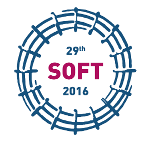Speaker
Bill Huang
(Tokamak Energy)
Description
Spherical Tokamaks used in magnetic fusion have a small centre stack by design. This causes a very high field on the conductor. ST40 is a 3 Tesla spherical tokamak with a major radius of R=40cm and minor radius of a=26cm being built by Tokamak Energy. The high toroidal field (TF) requirement requires a wire current of 250kA flowing in each of the 24 limbs totalling 6 MA in the centre stack. Joint testing was used to investigate the interface resistance between the centre stack and return limbs under a variety of contact pressures, using different shims, different coatings on the conductor and soldering. Initially a DC 400A current source was used and later an air-core pulsed transformer delivering up to 16kA of current was specifically designed and built for these measurements. Results from this paper can be used to predict the behaviour of critical joints in the region at the ends of the centre stack where current is passed to the TF return limbs. A comparison with TF joint data from the National Spherical Torus Experiment (NSTX) is also given. This will aid in deciding which jointing method to use for ST40 and the required pressure to pre-load the interface.
Co-authors
Adrian McFarland
(Tokamak Energy, Oxfordshire, United Kingdom)
Alan Sykes
(Tokamak Energy, Oxfordshire, United Kingdom)
Bill Huang
(Tokamak Energy, Oxfordshire, United Kingdom)
John Ross
(Tokamak Energy, Oxfordshire, United Kingdom)
Mick Mason
(Tokamak Energy, Oxfordshire, United Kingdom)
Paul Noonan
(Tokamak Energy, Oxfordshire, United Kingdom)

